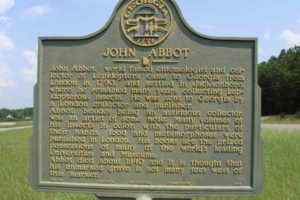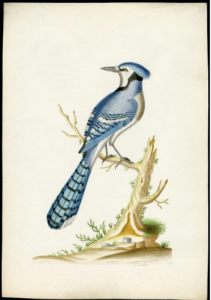 This week’s #MarkerMonday examines the John Abbot historical marker in Screven County. As a naturalist,entomologist, and ornithologist, John Abbot (1751-c. 1840) spent his life studying nature, insects, and birds. He is particularly known for his detailed drawings of birds and lepidopterous insects, the class of insects including butterflies and moths. While he lived in England, he was introduced to Dru Drury, a jeweler with an interest in entomology. Drury coordinated naturalist expeditions to England’s colonies, and inspired Abbot to travel to the colony of Virginia in July of 1773.
This week’s #MarkerMonday examines the John Abbot historical marker in Screven County. As a naturalist,entomologist, and ornithologist, John Abbot (1751-c. 1840) spent his life studying nature, insects, and birds. He is particularly known for his detailed drawings of birds and lepidopterous insects, the class of insects including butterflies and moths. While he lived in England, he was introduced to Dru Drury, a jeweler with an interest in entomology. Drury coordinated naturalist expeditions to England’s colonies, and inspired Abbot to travel to the colony of Virginia in July of 1773.
During his voyage to Virginia, Abbot met the Goodalls, a couple traveling to Virginia with a large supply of goods and the intention of opening a store, and continued to travel with them to Hanover County, about 100 miles inland. He was disappointed in his Virginia findings and even more discouraged when his first two collections of drawings and specimens were lost in storms on return to England. He decided to travel to Georgia with a relative of the Goodalls and helped finance the journey.
Abbot settled in Georgia in 1776, about 30 miles south of Augusta in today’s Burke County, and began collecting and drawing specimens. He sent them to his dealer in London, John Francillon, who sold them to collectors in Europe. Although his drawings were scattered across Europe and America, very few of his works were published—his most notable is perhaps The Natural History of the Rarer Lepidopterous Insects of Georgia Collected from Observations by John Abbot published by Sir James Edward Smith in 1797. His drawings highlighted the insects’ life stages and he authored details about their habits. Abbot spent 60 years in Georgia between Burke, Screven, Bulloch, and Chatham counties studying and recording birds and insects until his death in c. 1840.
Explore the links below to learn more:
Related Marker Text - John Abbot (1751-1839)
New Georgia Encyclopedia - John Abbot (1751-ca. 1840)
The Georgia Historical Quarterly has published an article relating to John Abbot which can be accessed on JSTOR. If your library does not have access to JSTOR, you can go to www.jstor.org and create a free MyJSTOR Account.

